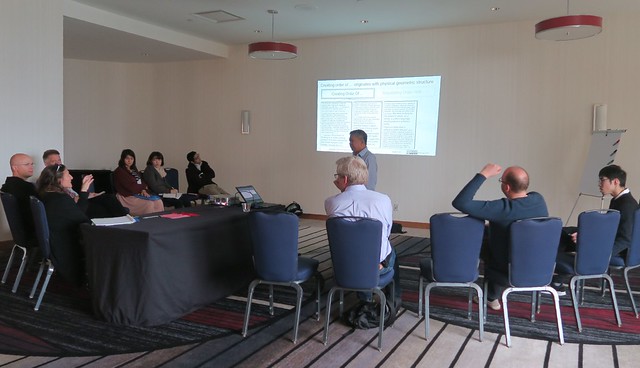Positioning “A Pattern Language” more like “Creating Order of”, then “The Timeless Way of Building” more like “Negotiating Order with”, was a productive framing to discuss the systems theory inside Christopher Alexander’s thinking (as well as positioning “The Nature of Order“).
The purpose of a workshop on “Negotiating Order with Generative Pattern Language” at PLoP 2017 was to open up discussions that could deepen the foundational understanding in linkages between pattern language and systems thinking. At least three of us routed to Vancouver BC for a Monday morning start, in a quick trip from the Purplsoc meeting in Austria that finished on Saturday. The PLoP program emphasizing writers’ workshops meant that our 90-minute dialogue didn’t conflict with any presentations.
On the audio recording, active participants in the sensemaking included Helene Finidori and Christian Kohls. With a more relaxed pace, the open time after the slides were completed allowed some pattern language novices to also have questions answered.

The frame for discussion was slides that had previously been posted on the Coevolving Commons.
The digital audio recording has been matched up with slides, for a less ambiguous viewing as a web video.
For observers who prefer to be mobile, video files can be downloaded directly on a device.
| Video |
H.264 MP4 |
WebM |
Digital video
(1h38m45s) |
[20171023_PLoP_Ing NegotiatingOrder HD 537kpbs m4v]
(HD 537Kbps 379MB) [on the Internet Archive]
[20171023_PLoP_Ing NegotiatingOrder nHD 214kpbs m4v]
(nHD 214Kkps 151MB) |
[20171023_PLoP_Ing NegotiatingOrder HD 348kpbs webm]
(HD 348Kbps 245MB)
[20171023_PLoP_Ing NegotiatingOrder nHD 168kpbs webm]
(nHD 168Kbps 119MB) |
The downloadable audio recording includes the conversation of all participants.… Read more (in a new tab)
Positioning “A Pattern Language” more like “Creating Order of”, then “The Timeless Way of Building” more like “Negotiating Order with”, was a productive framing to discuss the systems theory inside Christopher Alexander’s thinking (as well as positioning “The Nature of Order“).
The purpose of a workshop on “Negotiating Order with Generative Pattern Language” at PLoP 2017 was to open up discussions that could deepen the foundational understanding in linkages between pattern language and systems thinking. At least three of us routed to Vancouver BC for a Monday morning start, in a quick trip from the Purplsoc meeting in Austria that finished on Saturday. The PLoP program emphasizing writers’ workshops meant that our 90-minute dialogue didn’t conflict with any presentations.
On the audio recording, active participants in the sensemaking included Helene Finidori and Christian Kohls. With a more relaxed pace, the open time after the slides were completed allowed some pattern language novices to also have questions answered.

The frame for discussion was slides that had previously been posted on the Coevolving Commons.
The digital audio recording has been matched up with slides, for a less ambiguous viewing as a web video.
For observers who prefer to be mobile, video files can be downloaded directly on a device.
| Video |
H.264 MP4 |
WebM |
Digital video
(1h38m45s) |
[20171023_PLoP_Ing NegotiatingOrder HD 537kpbs m4v]
(HD 537Kbps 379MB) [on the Internet Archive]
[20171023_PLoP_Ing NegotiatingOrder nHD 214kpbs m4v]
(nHD 214Kkps 151MB) |
[20171023_PLoP_Ing NegotiatingOrder HD 348kpbs webm]
(HD 348Kbps 245MB)
[20171023_PLoP_Ing NegotiatingOrder nHD 168kpbs webm]
(nHD 168Kbps 119MB) |
The downloadable audio recording includes the conversation of all participants.… Read more (in a new tab)



